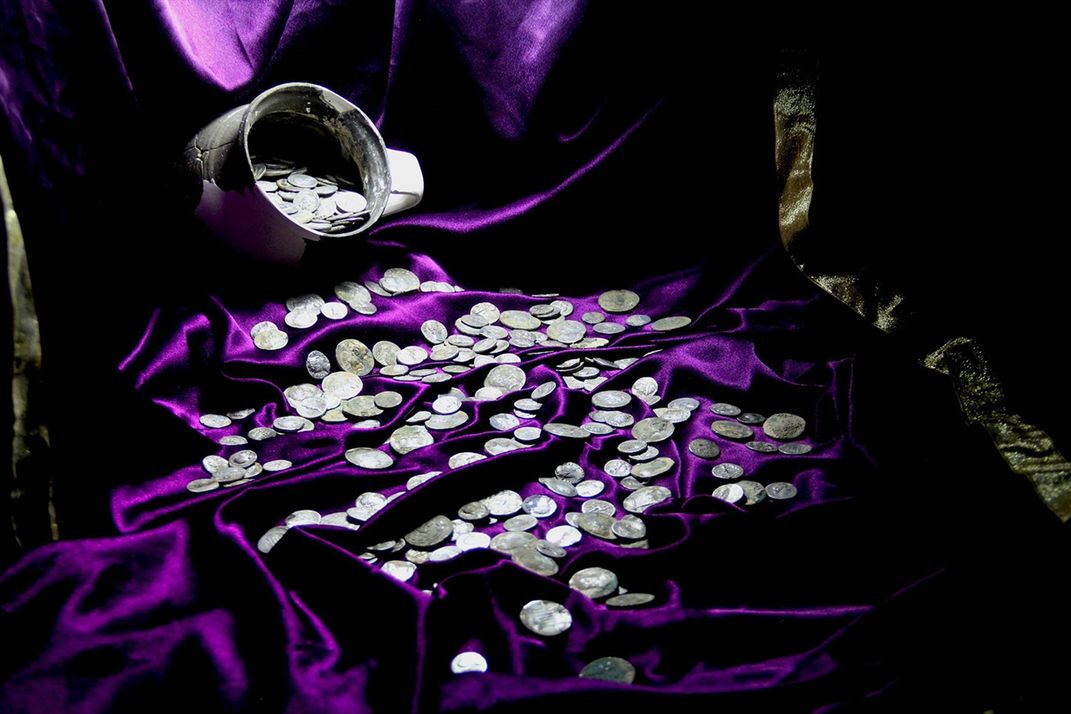Trove of 650 Coins Bearing Likenesses of Caesar, Mark Antony Unearthed in Turkey
Minted between 75 and 4 B.C., the silver currency was probably buried by a high-ranking Roman soldier during Augustus’ reign
:focal(854x561:855x562)/https://tf-cmsv2-smithsonianmag-media.s3.amazonaws.com/filer/2c/40/2c40126b-aacd-44c1-a652-04e4c0090cf2/xl_0a8b3f3f-9f78-4d8c-b9d5-8d8236b97efd.jpg)
Archaeologists in the ancient Turkish city of Aizanoi have discovered a cache of 651 Roman coins in a vessel buried near a stream, reports Muharrem Cin for the state-run Anadolu Agency.
“The jug was aimed to be kept [in place] by three terracotta plates covering it,” lead archaeologist Elif Özer of Pamukkale University tells the Hurriyet Daily News, adding that that the coins were likely buried during Emperor Augustus’ reign (27 B.C.—14 A.D.).
Per a statement, the scholars concluded that 439 of the coins were denarii, a type of silver coin first introduced in the third century B.C., while 212 were cistophori, or silver coins from Pergamum, an ancient Greek city in what is now Turkey. Though the researchers discovered the coins in 2019, they weren’t able to examine them until recently due to the Covid-19 pandemic.
In the statement, as translated by CNN’s Jack Guy, Özer describes the coins, which were minted in Southern Italy, as not only a “very special and unique collection,” but “the most special silver coin find of recent times.”
Dated to between 75 and 4 B.C., the coins bear the images of Roman emperors and politicians, including Julius Caesar, Marcus Brutus and Mark Antony, writes Live Science’s Laura Geggel. When studying the artifacts, researchers found that many of the coins were well-preserved, with their engravings still legible.
Özer theorizes that the denarii and cistophori were part of a coin album—a compilation of money portraying rulers from the late Roman Republic—that belonged to an elite Roman soldier. Some of the coins were more valuable than others.
“A high-ranking soldier [likely] came to Aizanoi ... and he must have buried these coins here for a reason we do not know yet,” Özer tells Live Science.
According to Özer, each coin “tells a different story” drawn from mythology and popular lore. One token, for instance, portrays the Trojan hero Aeneas carrying his father, Anchises, on his back—a reference to a well-known scene from Virgil’s Aeneid, notes Live Science.
As Mark Cartwright wrote for Ancient History Encyclopedia in 2018, denarii were the Romans’ most popular coins between 211 B.C. and the third century A.D. Cistophori were rarer than denarii, as they were only in circulation around Asia Minor, according to the Dictionary of Greek and Roman Antiquities.
The Daily Sabah reports that the team uncovered the coins as part of a broader restoration effort that began in 2011. Dubbed the Aizanoi Penkalas Project, the campaign seeks to offer riverboat tours that enable visitors to mirror the ancient Romans’ maritime journeys while exploring Aizanoi’s ancient ruins. Other artifacts discovered at the site include 1,000 Roman stones and sculptures and traces of a settlement dated to 3000 B.C., noted the Daily Sabah in a separate 2020 article.
According to the Anadolu Agency, Özer and her colleagues plan to soon publish their findings in a scientific journal. For now, the coin collection will remain on display at the Museum of Anatolian Civilizations in the Turkish capital of Ankara.
/https://tf-cmsv2-smithsonianmag-media.s3.amazonaws.com/accounts/headshot/Isis_Davis-Marks_thumbnail.png)
/https://tf-cmsv2-smithsonianmag-media.s3.amazonaws.com/filer/43/ce/43ce300c-1b53-496f-9edb-5dd169b49e0c/xl_04090ebd-ebce-4be3-9060-5c2b5d515896.jpg)

/https://tf-cmsv2-smithsonianmag-media.s3.amazonaws.com/filer/62/88/62889a8e-d956-4a5c-89ef-7440953d2564/xl_cb6e1367-87e9-4155-97e3-d7b79853d952.jpg)
/https://tf-cmsv2-smithsonianmag-media.s3.amazonaws.com/accounts/headshot/Isis_Davis-Marks_thumbnail.png)